Have you ever cracked open a book, eager to dive into its main content, only to encounter a series of mysterious pages before reaching Chapter 1? These pages, collectively known as the front matter of a book, go beyond mere formality. They’re like the backstage area of a theater; while some might think they are unimportant, they set the stage for your book’s main content.
But what exactly is this front matter and why should you (as an author) care about it? We are going to answer these questions, and more, in this article. And by the end, you’ll know how to create a front matter that impresses readers and reviewers alike.

What Is the Front Matter of a Book?
The front matter of the book refers to all the different parts that are added before the main content of this book. This could be the title page, introduction, copyright page, and much more. Essentially, the front matter acts as a guide that provides your readers with initial information and context about your book. It also sets the tone for what is to come, and you can make use of it to set a strong first impression for your readers.
Important Tips on Front Matter Formatting
There are a couple of formatting aspects to keep in mind while working on the front matter of your book. These are:
- Starting on the right-hand page: Most parts of the front matter start on the right-hand page (also known as the recto page), except for the praise for the book, frontispiece, and copyright page (more on each of them later in the article).
- Adding blank pages: It’s always recommended to include blank pages between the different parts of the front matter. These pages create a clean separation between different sections, making the book more visually appealing.
- Including page numbers: The sections of the front matter that come before the table of contents don’t have page numbers. However, the ones that follow the table of contents use Roman numerals for their page numbering.
The Different Parts of the Front Matter (How to Write the Front Matter of the Book)
There are several parts that you can add to the front matter of your book. What you choose to include depends on your preference and the main content of your book. For example, most fiction books won’t have a preface in their front matter. With that said, it is important to note that there are some essential parts that should be included, such as the title page and copyright page.
Now let’s examine the different parts of this section in more detail. But before we do, it’s worth noting that while the typical order of front matter follows the sequence below, some publishers may have their own preferences or variations.
1. Praise for the Book (Recommended)

What is the best thing readers can see when they open your book? Quotes that praise it, of course. This page can persuade them to purchase your book, as it includes reviews and endorsements from influential readers and reputable institutions (such as the New York Times).
The praise page is usually found on the first right-hand page of the book, right after the cover. It can include a header but doesn’t contain any page numbers.
2. About the Author (Optional)
Typically a few lines long, the about the author part of the front matter sheds light on the author’s background and experience. While this section can be included in the back matter, having it at the beginning of your book can give your readers a brief introduction to you and showcase your expertise.
You can add this page right after the “Praise for the Book” section, with a header (e.g. About the Author) and without page numbers. Its placement on the right- or left-hand page depends on where the previous section ends.
For example, if the “Praise for the Book” ends on the right-hand page, then the “About the Author” page should be on the left-hand page, and vice versa. But If your front matter doesn’t include a “Praise for the Book” section, then the “About the Author” page can be the first right-hand page of the book.

About the Author Page Example: The Road Less Traveled
3. Other Work/Series Title (Optional)

If this isn’t your first book and you’d like to promote your other work, or if the book you’re working on is part of a series, then you can mention your previous books on this page.
The Other Work section can be placed after the “About the Author” page, or on the first left-hand page of your book. Either way, this section usually comes with a header (e.g. Also by the Author), but without any page numbers.

Other Work by the Author Page Example: Big Magic
4. Half-Title Page (Optional)

Some authors and publishers prefer to add a page at the beginning of the front matter with just the title of the book. It doesn’t contain anything else, not even the subtitle if there is one. If you would like to add an aesthetic touch, you can add some ornaments (subtle decorations such as a delicate border).
Originally, this page was created to protect the title page during the bookbinding process. That is why it is less common now with digital printing, but you can still find it in some books.

Half-Title Page Example: Big Magic
5. Frontispiece (Optional)
A frontispiece is an ornamental or illustration that is usually placed on the left-side page, opposite to the title page. Its main purpose is to showcase certain thematic elements or scenes from the book, and sometimes it displays the author’s portrait.
These pages first appeared in medieval illuminated manuscripts, and they often depicted the book being presented to someone. Even though they are less common nowadays, they might still be found in limited or special editions, as well as fine-art books.
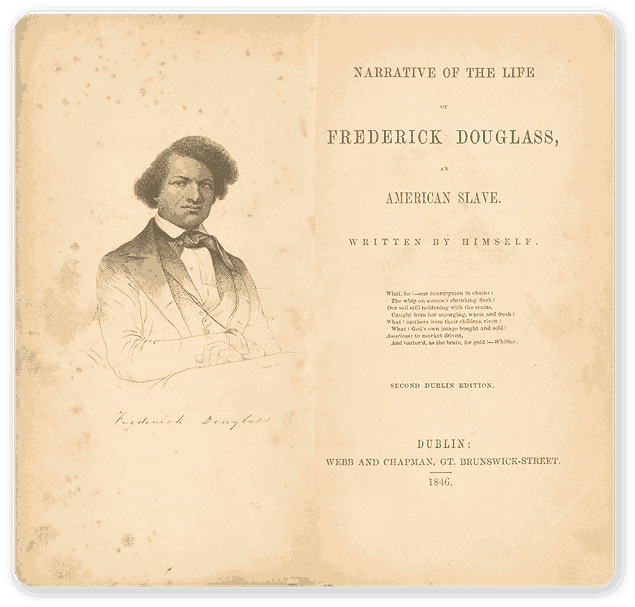
Frontispiece Page Example: Narrative of the Life of Frederick Douglass
6. Title Page (Mandatory)

This is where the important book information goes. On this page, you can find the title in the middle of the page in a large font, followed by the subtitle in a smaller font. You can also find the name of the author(s) at the bottom of the page (not preceded with the word “by”). It may also contain the publisher’s name and logo.
The title page is usually on the right-facing page. It doesn’t contain any headers or page numbers. This page can be very useful for librarians and academics, as it helps them in referencing and cataloging.

Title Page Example: Big Magic
7. Copyright Page (Mandatory)
The copyright page is one of the most important pages in the front matter; it mainly provides legal protection for your book in case of copyright infringement. It also provides important information about the book, including:
- Copyright notice
- Rights reserved notice
- ISBN
- Disclaimers
- Permissions notice
- Credits
- Publisher information
Usually, the copyright page is placed on the left-side page, on the back of the title page. And just like the title and half-title pages, it doesn’t contain headers or page numbers.
Important read: Ebook Copyright Page: How and Why to Make It (With Templates & Examples)

Copyright Page Example: Big Magic
8. Dedication (Optional)

This part of the front matter represents a heartfelt space where the author pays tribute to a person, group, or cause. It is usually short and sweet, no longer than 2 or 3 lines.
Coming after the copyright page, the dedication goes on the right-hand page. It is worth noting that this page usually doesn’t contain headers or page numbers.

Dedication Page Example: Braving the Wilderness
9. Epigraph (Optional)
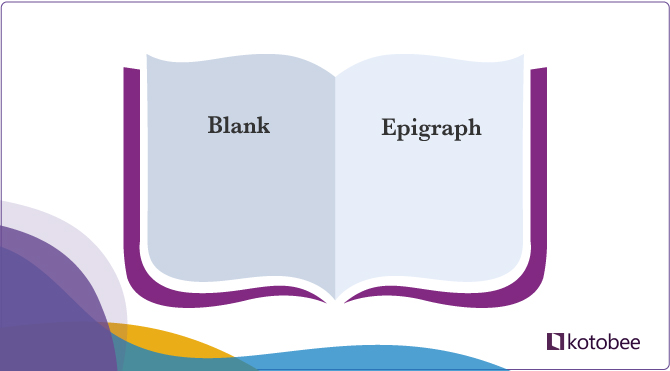
Common in both fiction and non-fiction books, epigraphs are short quotations of phrases that encapsulate the work’s main themes and set the tone. They can add depth to your work and invite readers to explore the layers of meaning within your book.
The epigraph section is typically on the right-hand page, without any headers or page numbers. The quote or phrase is usually placed in the middle of the page, with the name of the author or the source of the quotation underneath.

Epigraph Page Example: Big Magic
10. Table of Contents (Recommended)
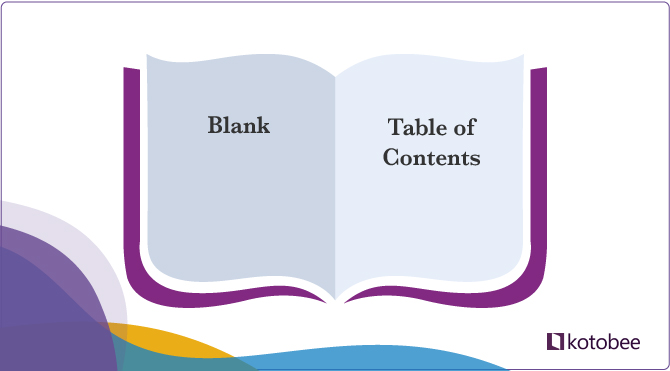
The table of contents (ToC) is essentially a list of your book’s different sections and their corresponding page numbers. This list can either include the main sections only, or it can also have their subsections. It is also important to note that the ToC can list parts of the front matter that come after it, such as the introduction or the preface.
The ToC page always falls on the right-hand page. It can contain a header (e.g. Contents), but it does not have a page number.
Important read: The Art of Crafting a Table of Contents

Table of Contents Page Example: Big Magic
11. Foreword (Optional)

Often written by someone other than the author (such as a subject matter expert or a well-known figure), the foreword section acts like a letter of reference that helps authors gain their readers’ trust. Think of it as an endorsement or an introduction from an authoritative source.
Just like the majority of the front matter parts, the foreword page starts on the right-hand page. It also has a header (e.g. Foreword) and page numbers. Keep in mind, however, that the numbers in the front matter pages that follow that table of contents are usually Roman numerals.
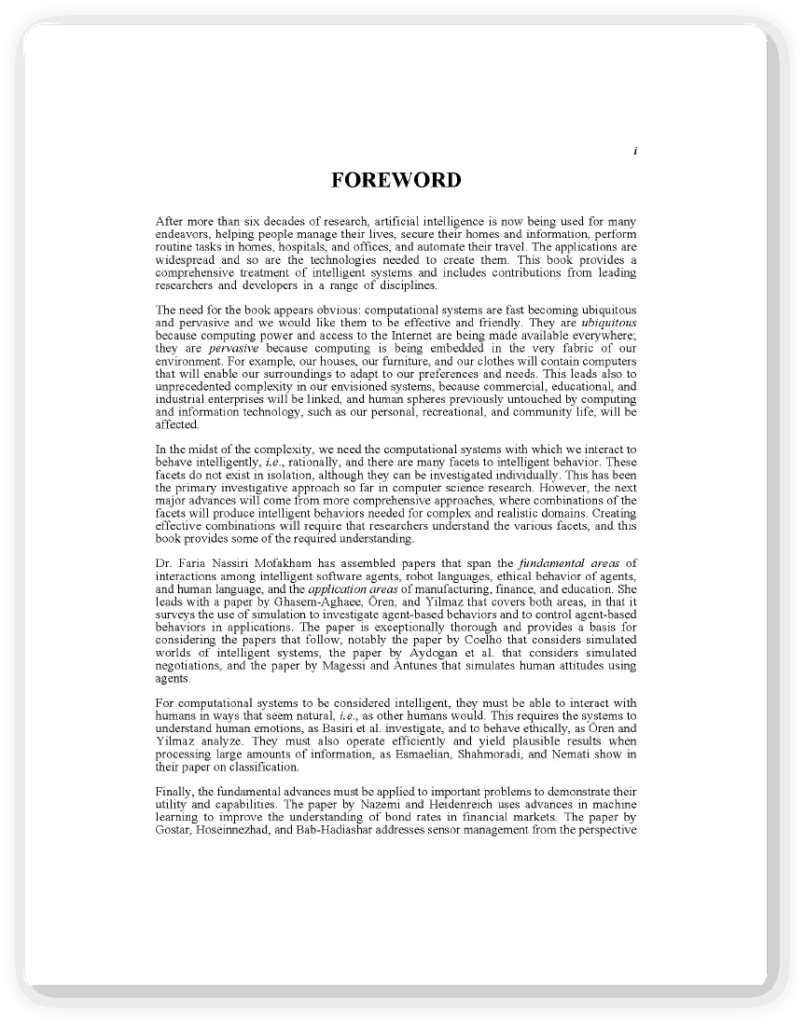
Foreword Page Example: Current and Future Developments in Artificial Intelligence
12. Preface (Optional)

If you would like to share with your readers how your book came to be, then the preface is where you can do this. For example, you can describe your thought process as you wrote the book, how you researched the different topics you’re going to discuss, or the goals you want to achieve through this book. While used more in non-fiction books, you can still add a preface to your fiction work.
Placed on the right-hand page, this section starts with a header (e.g. Preface) and has Roman numerals page numbers.
Important read: How to Write a Book Preface (with Examples & Templates)

Preface Page Example: The Picture of Dorian Gray
13. Acknowledgments (Optional)
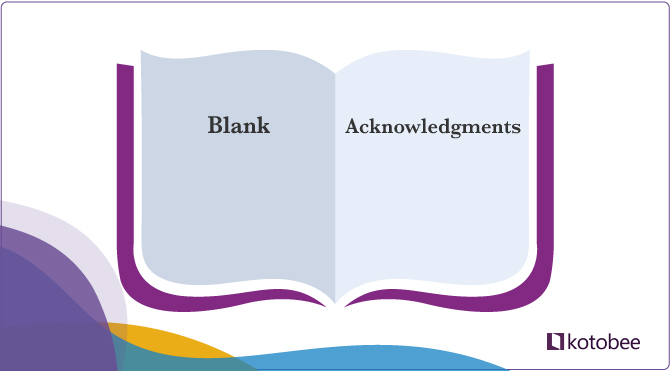
In the acknowledgments section, you express gratitude to those who contributed to the creation of your book. Those could be mentors, colleagues, family members, or friends. You can also acknowledge the role of your agent, editor, or anyone who helped you professionally.
The placement of the acknowledgments is completely flexible; you can either include it in the front matter or leave it to the end of the book (the back matter). If you decide to include it in the front matter, then you can place it on the right-hand page and include a header (e.g. Acknowledgments), as well as page Roman numerals.

Acknowledgment Page Example: The Highly Sensitive Person
14. Introduction (Recommended)

Written in both fiction and non-fiction books, introductions can offer your readers an outline of your book’s contents and let them know what’s to come. It acts as a hook that gives them a reason why they should turn to the first chapter, and also why they should make it all the way to the end of the book.
The introduction section can be just one page or it can go up to a few more. It starts on the right-hand page, includes a header (e.g. Introduction), and contains Roman numerals page numbers.
Important read: How to Write the Best Book Introduction (With Checklists & Examples)

Introduction Page Example: The Tipping Point
15. Prologue (Optional)

Last but not least comes the prologue, which is found mainly in fiction books. Its main purpose is to offer a backstory to the main events of a novel or reveal a scene that happened before these events.
Typically, a prologue can range from a few pages to about 10-15 pages, depending on the complexity of the information you want to provide your readers. It starts on the right-hand page with a header (e.g. Prologue) and has Roman numeral page numbers.

Prologue Page Example: A Game of Thrones: A Song of Ice and Fire
Final Thoughts
Think of the front matter of your book as a space where you can set the stage and create an inviting atmosphere for your readers. From the title page to the acknowledgments, each part has a purpose. So pay attention to these details—it’s like dressing up your book for a grand performance.
.
Read More
How to Format an Ebook for Publishing: A Step-by-Step Guide
Successful Book Launch Tips and Tricks for First-Time Authors

